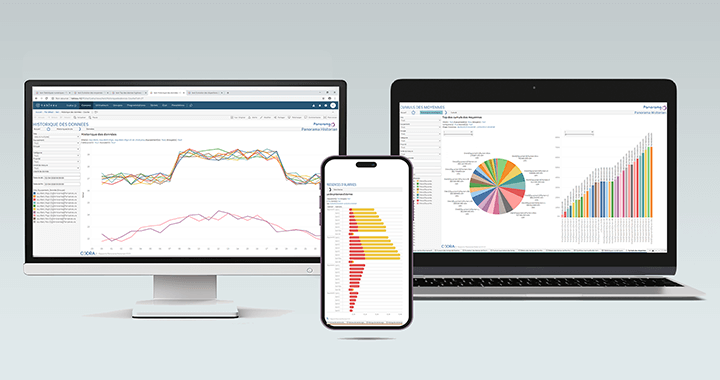Over the past ten years or so, commercial buildings have been equipped on a massive scale with BMS (Building Management Systems), enabling intelligent control of equipment: HVAC (heating, ventilation and air conditioning), electricity, opening systems, etc. These systems are supposed to facilitate the energy transition, by optimizing and rationalizing consumption. However, according to Ademe (French Agency for Ecological Transition), 65% of these systems are abandoned 5 years after installation.
How can we ensure that these systems are future-proof, and thus useful for the energy transition of commercial buildings? Well thought-out SCADA software can provide a range of solutions to this problem.
DPEB 2018/844: a highly ambitious European directive
To improve the energy efficiency of buildings within the European Union, the European Parliament adopted in 2018 the DPEB 2018/844, also known as the Energy Performance of Buildings Directive. Its main provisions are:
- Energy Efficiency Objectives: The directive sets targets for improving the energy performance of new and existing buildings. It also encourages the use of renewable energy sources.
- Minimum Standards: The directive establishes minimum standards for the energy performance of new and existing buildings.
- Inspections and Energy Performance Certificates: Buildings must be regularly inspected and an energy performance certificate must be issued. This certificate provides information on the energy performance of the building.
- Automation and Control: It promotes the use of automation and control systems to improve the energy performance of buildings.
How are those automation and control systems used? This topic is rarely addressed, even though it is crucial to the energy efficiency objectives of these buildings.
MImplementing unified, easy-to-use SCADA software
The equipment present in a building is often numerous, multi-brand and scattered throughout the infrastructure. Each piece of equipment uses its own communication protocol. The HMIs (Human Machine Interfaces) supplied with this equipment are often unintuitive and not specifically adapted to the various building trades. The use and maintenance of such a system quickly discourages teams.
The advantage of centralized SCADA systems is that all the equipment in a commercial building can be connected and visualized on the same platform: heating, electrical power, access control, etc. Panorama interfaces with field equipment and other systems via standardized protocols such as BACNET. Panorama interfaces with field equipment and other systems via standardized protocols such as BACNET. CODRA recently obtained BTL certification for its Panorama suite (2022 SP1). This approach fosters interoperability and facilitates the implementation of building control systems.
Above all, equipment is controlled via intuitive, ergonomic interfaces:
- Panorama’s development environment has been built around object technology (rather than adding to it), which facilitates the development of monitoring applications.
- CODRA has built up a network of expert integrators of the Panorama Suite platform. These local companies offer technical expertise for the implementation, use and evolution of SCADA applications developed with Panorama.
Energy efficiency plan: building an organized approach
In a commercial building, every piece of equipment is a potential source of energy savings. The temptation for system operators is to open all the doors at the same time, which can prove inefficient. It’s important to have a roadmap, with precise objectives.
A SCADA platform such as Panorama makes this possible. A SCADA application developed under Panorama gives building managers a 360° view of the building’s condition, and facilitates the implementation of a step-by-step energy efficiency plan. For example, they can first focus on the efficiency of electrical systems, followed by ventilation, heating, etc. Panorama’s centralized management of equipment makes it easier for teams to react and correct any deviations. This is all the more useful for new equipment: although it is naturally more efficient than old equipment, it needs to be adjusted from the outset. In this way, they will be more easily adopted.
HMI for commercial buildings: involving and mobilizing all stakeholders
The energy transition is everyone’s business, and this is also true for commercial buildings. Maintainers need to involve all building users, without which it will be difficult to achieve real change management. This involvement can be achieved by two methods: involving and informing them.
With Panorama, operators and application integrators can create dedicated interfaces for building users. The latter will be able to control the equipment that concerns them, such as air conditioning or opening systems (blinds, windows). In addition to more appropriate and dynamic control, this means greater comfort for building users.
Panorama’s comprehensive suite includes the “Panorama H2” Data Historian platform, dedicated to data centralization and processing. Within this platform, the H2 Reporting module enables operators to create reports on the building’s energy consumption. These reports can then be passed on to building users to keep them up to date with the ongoing energy transition.
While we often think of design when we talk about decarbonizing buildings, we mustn’t neglect operation. Making buildings more efficient is the most direct way to reduce energy consumption. An efficient building needs efficient equipment, and the SCADA system plays a key role in this objective: building management and control will be simplified, the energy transition process will be structured, and all players will be mobilized.






